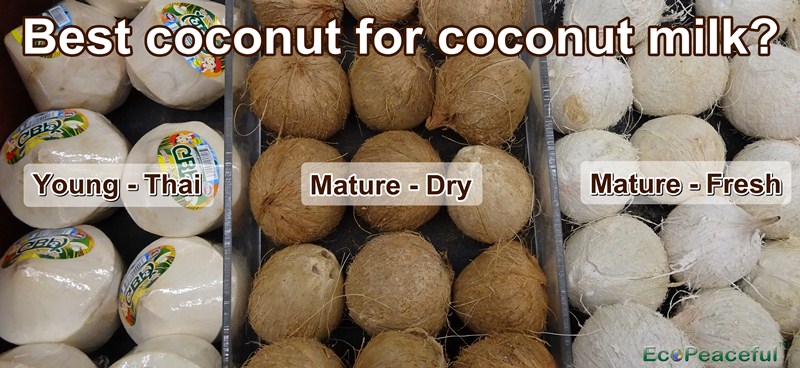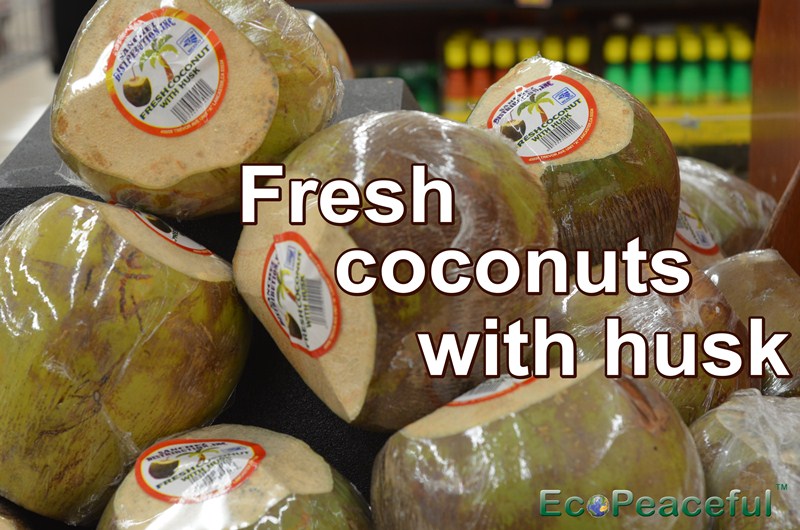4 Ways to Make Coconut Milk. What Coconut or Coconut Product to Choose for Making Coconut Milk?
WHAT, ENSLAVED MONKEYS? - I was using Young Thai coconuts, until I found out that there may be as much as 99% of the Thai coconuts being picked by enslaved and abused monkeys.
COCONUTS - Free from Monkey Slavery & Abuse - Many stores that sell coconuts offer a few different types of coconuts: 1) young Thai (white, with husk), 2) mature - dry (brown, without husk), 3) mature - fresh (white, without husk) and 4) fresh (green, with husk). For the freshest and lowest cost, I buy coconuts in the Mexican or Asian markets.
Coconut Milk - From young Thai coconuts (white, with husk) - White coconuts with a flat round base and a cone shaped top and wrapped in plastic. I consider these to be the best-tasting of the coconuts.
Thai coconut water is sweetest, and the 'meat' is the softest, almost jelly like.
If you use young Thai for making coconut milk, it does not require straining. Just blend the coconut meat with the coconut water (or regular water) and be prepared to drink sweet coconut milk. Not all coconuts have the same amount of meat, so the thickness of milk will depend on the amount of coconut meat and water.
Not Ethical/Vegan- Unfortunately, in Thailand, it is estimated that 99% of the coconuts are harvested by enslaved monkeys (macaques), so this kind of practice is definitely not considered ethical or Vegan, which is why I am not buying them anymore. This harvesting practice is not just in Thailand - Sri Lanka, Indonesia, Malaysia, India and other countries in the region also use monkeys.
There are lists of companies on the internet that claim that they do not use monkeys, yet based on my personal experiences, I do not automatically trust any company just on their words, because they could be and often are deceiving/lying. I would guess that some of these companies may have never even seen the coconut farm(s) they buy from and/or have independently investigated where their coconuts come from, since they just buy coconuts wholesale or buy already processed coconut products. So, to be sure I would only buy from countries that I am sure do not use monkeys. According to my research, Mexico does not use monkeys. NOTE: If a coconut product says, "Made in USA" (e.g. coconut oil, butter, shreds...), it does not mean that the coconuts are grown in the USA. Made in USA, usually refers to the processing, and not where it was grown, so can be made from 100% imported product(s).
Coconut milk - From mature- dry (brown, without husk) coconut - Water is often much less compared to other coconuts and not good for drinking. The meat is good for coconut milk, but it will require straining to make smooth coconut milk.
Coconut milk - From mature fresh (white, without husk) coconut - These offer a good quality water and milk product, but are fibery, so it requires straining to make smooth coconut milk.
Coconut milk - From fresh/green coconuts (green, with husk) - They often have their top and bottom trimmed off. The are very sweet and tasty, similar to young Thai coconut. They are often found in Mexican Markets for about $2-$3 each. They are very good quality for both water and meat, great for smoothies, some can be little too fibery for coconut milk without staining.
Coconut milk - From shredded coconut or coconut flakes - A low-cost option that does not require opening coconut. Usually sold in bulk, but it makes hard to identify where coconut was grown, since bulk items usually not labeled the country of origin.
Coconut milk - From coconut butter - This is the whole coconut, not just oil. Nutiva
INGREDIENTS
For 1 Batch(es)
Recipe
- Coconut
- Warm water (higher than 80F), but not too hot, so you do not burn your hands while straining
- Sweetener (optional)
- Vanilla powder (optional)
DIRECTIONS
- Blend all ingredients well - until smooth. If required, strain through the nut milk bag (see important info on nut milk bags in the notes below).
WAY #1: Mature - dry (brown, without husk), mature - fresh (white, without husk) - 1/2 coconut blend with 4 cup coconut water and/or warm* water. Do not use the water from dry (brown) coconut. Strain coconut pulp through the nut milk bag. Very tasty coconut milk.
WAY #2: Fresh (green, with husk) - Blend coconut meat with water and/or coconut water. The amount of water will depend on how much coconut meat in the coconut, the amount of meat can vary significate based on the maturity of the coconut. Straining may not be needed. Only use warm* water if you are planing to strain.
WAY #3: Shredded Coconut or Coconut Flakes - Blend 1 cup of coconut flakes or shreads with 2-3 cups of warm* water. Strain coconut pulp through the nut milk bag. Milk not as tasty as from a coconut, it has a strange aftertaste, but adding vanilla powder and sweetener masks the after taste.
WAY #4: Coconut Butter - 1/2 cup coconut butter blend with 4 cups warm* water. No straining needed, but some people consider this coconut milk to be a little grainy in texture. Tastes similar to coconut milk from coconut shreds or flakes.
*warm water (80-120F) is very important for making coconut milk. If water/coconut mixture will be below 76F (melting point of coconut oil) than most of oil will be left in coconut pulp and milk will be very thin/watery and tasteless. - Refrigerate and/or serve cold. Coconut milk will separate into cream and water, to bring back to milk - just shake it.
Recipe notes
EQUIPMENT
Blender - Good news! You do not need a high-powered, high-speed blender (such as Vitamix or Blendtec) for making any nut milk. NOTE: BPA-free blenders are not truly BPA free - according to independent studies. We recommend using a glass jar blender without plastic on the bottom (Dynablend Clean DB-950 or Oster Pro 1200 both have stainless steel on the bottom) to avoid toxic chemicals from plastic leaching into your food. Click here to watch our videos for more details.
If you are unable to access fresh young coconuts, you will need blend and strain the pulp from mature coconuts, using a nut milk bag or strainer since the mature coconuts are very fibery.
Nut Milk Bag - To avoid eating synthetic fibers and leaching toxic chemicals into your food, from synthetic (nylon) nut milk bags (often just relabeled paint strainers), I recommend using a 100% organic or natural nut milk bag.
NOTE: On Amazon.com there are many fake nut milk bags that claim to be "organic" but are in fact not organic, and not even fully "natural". We tested (video) several "organic" nut milk bags, and all of them had fraying synthetic threads and even glue on the end of the threads when they claim they use organic cotton threads and do not use any glues!
Video: FAKE Organic Nut Milk Bags (not even 100% natural) on Amazon. Textile Burn Test.
Article:EXPOSED! Fake Organic Hemp Nut milk Bags sold on Amazon!
Strainer - If you do not have a nut milk bag, a fine mesh stainless steel strainer will also work well if you are only working with a small amount of milk (1 cup or less).
SUGGESTIONS FOR RECIPE INGREDIENTS:
DATES - Why choose dates over other sweeteners? - Dates and/or date sugar are the most nutritious sweetener. Here is Dr. Michael Greger video The Healthiest Sweetener. I usually buy whole dates from a local farm, but if local dates are not an option for you, here is a great website for different varieties and good price value for boxed organic dates and they are shipped in cardboard boxes (Yay, no plastic boxes/shells!). Date palms grow very well in a desert environment, so no need to cut down tropical rainforest forest or burn fields as a common practice for cane sugar (very violent practice, wildlife gets trapped and burned alive). I live in Las Vegas, Nevada, USA, and we even have date palm trees growing in parking lots, but unfortunately just for decoration. I was inspired to plant date palms in my own yard.
VANILLA - Why vanilla bean is different from vanilla extract? - I used to use organic vanilla extract (alcohol based), but according to this Dr. Michael Greger video: Breast Cancer and Alcohol: How Much is Safe? there is no safe alcohol level. So, I switched to using vanilla powder or whole vanilla beans. Since I could only find vanilla beans or vanilla powder in plastic packaging, I buy at least a pound. This way it will last me for several years and less plastic packaging is used.
|
|
|


